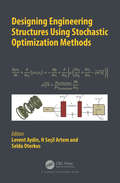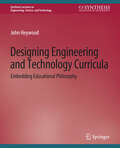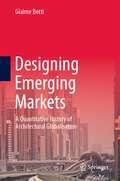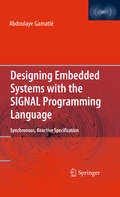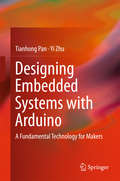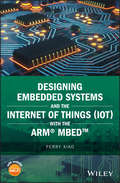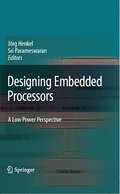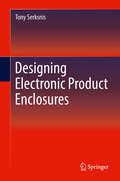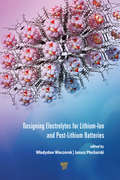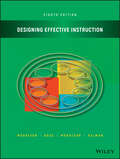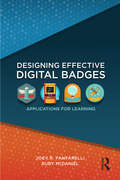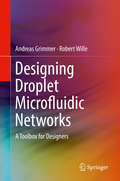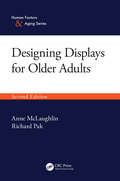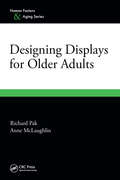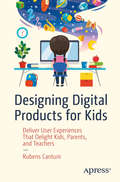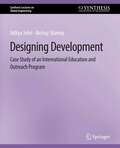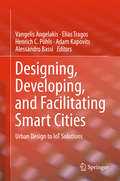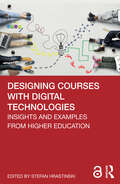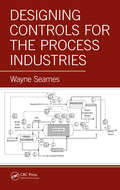- Table View
- List View
Designing Engineering Structures using Stochastic Optimization Methods
by Levent Aydin; H Seçil Artem; Selda OterkusAmong all aspects of engineering, design is the most important step in developing a new product. A systematic approach to managing design issues can only be accomplished by applying mathematical optimization methods. Furthermore, due to the practical issues in engineering problems, there are limitations in using traditional methods. As such, stochastic optimization methods such as differential evolution, simulated annealing, and genetic algorithms are preferable in finding solutions in design optimization problems. This book reviews mechanical engineering design optimization using stochastic methods. It introduces students and design engineers to practical aspects of complicated mathematical optimization procedures, and outlines steps for wide range of selected engineering design problems. It shows how engineering structures are systematically designed. Many new engineering design applications based on stochastic optimization techniques in automotive, energy, military, naval, manufacturing process and fluids-heat transfer, are described in the book. For each design optimization problem described, background is provided for understanding the solutions. There are very few books on optimization that include engineering applications. They cover limited applications, and that too of well-known design problems of advanced and niche nature. Common problems are hardly addressed. Thus, the subject has remained fairly theoretical. To overcome this, each chapter in this book is contributed by at least one academic and one industrial expert researcher.
Designing Engineering and Technology Curricula: Embedding Educational Philosophy (Synthesis Lectures on Engineering, Science, and Technology)
by John HeywoodThe intention of this book is to demonstrate that curriculum design is a profoundly philosophical exercise that stems from perceptions of the mission of higher education. Since the curriculum is the formal mechanism through which intended aims are achieved, philosophy has a profound role to play in the determination of aims. It is argued that the curriculum is far more than a list of subjects and syllabi, or that it is the addition, and subtraction, of items from a syllabus, or whether this subject should be added and that subject taken away. This book explores how curricular aims and objectives are developed by re-examining the curriculum of higher education and how it is structured in the light of its increasing costs, rapidly changing technology, and the utilitarian philosophy that currently governs the direction of higher education. It is concluded that higher education should be a preparation for and continuing support for life and work, a consequence of which is that it has to equip graduates with skill in independent learning (and its planning), and reflective practice. A transdisciplinary curriculum with technology at its core is deduced that serves the four realities of the person, the job, technology, and society.
Designing Emerging Markets: A Quantitative History of Architectural Globalisation
by Giaime BottiThis book offers a unique glance into the process of globalisation of the architectural practice during the last three decades through the lenses of innovative methodologies in architectural history based on quantitative data. Focusing on the golden age of globalisation (1990-2019), it investigates the transnational work of more than one thousand architectural firms of different business models from Europe, North America, and the Asia-Pacific in a broad sample of emerging markets: Mainland China, South-East Asia, India, the Persian Gulf, Sub-Saharan Africa, Russia and Kazakhstan, and Latin America. In the book, different thematic geographies are presented to explore the global scope of the contemporary profession, examine significant projects and the structural conditions behind them, and reveal the debates that such works generated. Understanding the global agency of design firms in emerging markets also becomes a way to study different market conditions, modes of production, and architectural trends comparatively and to highlight the shifts that occurred in the profession over the last few decades. The use of quantitative methodologies produces a novel and updated narrative on contemporary architecture in emerging markets grounded in quantitative data rather than in preassumptions and purely qualitative interpretations. Richly illustrated, this book is further enhanced by an ample set of maps, graphs, and tables to visualise data better.
Designing Embedded Systems with the SIGNAL Programming Language: Synchronous, Reactive Specification
by Abdoulaye GamatiéI am very pleased to play even a small part in the publication of this book on the SIGNAL language and its environment POLYCHRONY. I am sure it will be a s- ni?cant milestone in the development of the SIGNAL language, of synchronous computing in general, and of the data?ow approach to computation. In data?ow, the computation takes place in a producer–consumer network of - dependent processing stations. Data travels in streams and is transformed as these streams pass through the processing stations (often called ?lters). Data?ow is an attractive model for many reasons, not least because it corresponds to the way p- duction,transportation,andcommunicationare typicallyorganizedin the real world (outside cyberspace). I myself stumbled into data?ow almost against my will. In the mid-1970s, Ed Ashcroft and I set out to design a “super” structured programming language that, we hoped, would radically simplify proving assertions about programs. In the end, we decided that it had to be declarative. However, we also were determined that iterative algorithms could be expressed directly, without circumlocutions such as the use of a tail-recursive function. The language that resulted, which we named LUCID, was much less traditional then we would have liked. LUCID statements are equations in a kind of executable temporallogic thatspecifythe (time)sequencesof variablesinvolvedin aniteration.
Designing Embedded Systems with Arduino: A Fundamental Technology for Makers
by Tianhong Pan Yi ZhuIn this DIY guide, you will learn how to use Arduino – the open-source hardware board for makers, hobbyists, and inventors. You will learn how to develop your own projects, create prototypes, and produce professional-quality embedded systems. A simple step-by-step demonstration system accompanies you from vision to reality – and just like riding a bike, you’ll get better at it, the more you do it. Featuring a wealth of detailed diagrams and more than 50 fully functional examples, this book will help you get the most out of this versatile tool and bring your electronic inventions to life.
Designing Embedded Systems and the Internet of Things (IoT) with the ARM mbed
by Perry XiaoA comprehensive and accessible introduction to the development of embedded systems and Internet of Things devices using ARM mbed Designing Embedded Systems and the Internet of Things (IoT) with the ARM mbed offers an accessible guide to the development of ARM mbed and includes a range of topics on the subject from the basic to the advanced. ARM mbed is a platform and operating system based on 32-bit ARM Cortex-M microcontrollers. This important resource puts the focus on ARM mbed NXP LPC1768 and FRDM-K64F evaluation boards. NXP LPC1768 has powerful features such as a fast microcontroller, various digital and analog I/Os, various serial communication interfaces and a very easy to use Web based compiler. It is one of the most popular kits that are used to study and create projects. FRDM-K64F is relatively new and largely compatible with NXP LPC1768 but with even more powerful features. This approachable text is an ideal guide that is divided into four sections; Getting Started with the ARM mbed, Covering the Basics, Advanced Topics and Case Studies. This getting started guide: Offers a clear introduction to the topic Contains a wealth of original and illustrative case studies Includes a practical guide to the development of projects with the ARM mbed platform Presents timely coverage of how to develop IoT applications Designing Embedded Systems and the Internet of Things (IoT) with the ARM mbed offers students and R&D engineers a resource for understanding the ARM mbed NXP LPC1768 evaluation board.
Designing Embedded Systems and the Internet of Things (IoT) with the ARM mbed
by Perry XiaoA comprehensive and accessible introduction to the development of embedded systems and Internet of Things devices using ARM mbed Designing Embedded Systems and the Internet of Things (IoT) with the ARM mbed offers an accessible guide to the development of ARM mbed and includes a range of topics on the subject from the basic to the advanced. ARM mbed is a platform and operating system based on 32-bit ARM Cortex-M microcontrollers. This important resource puts the focus on ARM mbed NXP LPC1768 and FRDM-K64F evaluation boards. NXP LPC1768 has powerful features such as a fast microcontroller, various digital and analog I/Os, various serial communication interfaces and a very easy to use Web based compiler. It is one of the most popular kits that are used to study and create projects. FRDM-K64F is relatively new and largely compatible with NXP LPC1768 but with even more powerful features. This approachable text is an ideal guide that is divided into four sections; Getting Started with the ARM mbed, Covering the Basics, Advanced Topics and Case Studies. This getting started guide: Offers a clear introduction to the topic Contains a wealth of original and illustrative case studies Includes a practical guide to the development of projects with the ARM mbed platform Presents timely coverage of how to develop IoT applications Designing Embedded Systems and the Internet of Things (IoT) with the ARM mbed offers students and R&D engineers a resource for understanding the ARM mbed NXP LPC1768 evaluation board.
Designing Embedded Processors: A Low Power Perspective
by Jörg Henkel Sri ParameswaranTo the hard-pressed systems designer this book will come as a godsend. It is a hands-on guide to the many ways in which processor-based systems are designed to allow low power devices. Covering a huge range of topics, and co-authored by some of the field’s top practitioners, the book provides a good starting point for engineers in the area, and to research students embarking upon work on embedded systems and architectures.
Designing Electronic Product Enclosures
by Tony SerksnisThis book explains the design and fabrication of any electronic enclosure that contains a printed circuit board, from original design through materials selection, building and testing, and ongoing design improvement. It presents a thorough and lucid treatment of material physical properties, engineering, and compliance considerations such that readers will understand concerns that exist with a design (structural, environmental, and regulatory) and what is needed to successfully enter the marketplace. To this end, a main thrust of this volume is on the “commercialization” of electronic products when an enclosure is needed. The book targets the broadest audience tasked with design and manufacture of an enclosure for an electronic product, from mechanical/industrial engineers to designers and technicians. Compiling a wealth of information on relevant physical phenomena (strength of materials, shock and vibration, heat transfer), the book stands as a ready reference on how and where these key properties may be considered in the design of most electronic enclosures.
Designing Electrolytes for Lithium-Ion and Post-Lithium Batteries
by W 322 Adys 322 Aw Wieczorek Janusz P 322 OcharskiEvery electrochemical source of electric current is composed of two electrodes with an electrolyte in between. Since storage capacity depends predominantly on the composition and design of the electrodes, most research and development efforts have been focused on them. Considerably less attention has been paid to the electrolyte, a battery’s basic component. This book fills this gap and shines more light on the role of electrolytes in modern batteries. Today, limitations in lithium-ion batteries result from non-optimal properties of commercial electrolytes as well as scientific and engineering challenges related to novel electrolytes for improved lithium-ion as well as future post-lithium batteries.
Designing Electrolytes for Lithium-Ion and Post-Lithium Batteries
by Władysław Wieczorek; Janusz PłocharskiEvery electrochemical source of electric current is composed of two electrodes with an electrolyte in between. Since storage capacity depends predominantly on the composition and design of the electrodes, most research and development efforts have been focused on them. Considerably less attention has been paid to the electrolyte, a battery’s basic component. This book fills this gap and shines more light on the role of electrolytes in modern batteries. Today, limitations in lithium-ion batteries result from non-optimal properties of commercial electrolytes as well as scientific and engineering challenges related to novel electrolytes for improved lithium-ion as well as future post-lithium batteries.
Designing Effective Digital Badges: Applications for Learning
by Joey R. Fanfarelli Rudy McDanielDesigning Effective Digital Badges is a hands-on guide to the principles, implementation, and assessment of digital badging systems. Informed by the fundamental concepts and research-based characteristics of effective badge design, this book uses real-world examples to convey the advantages and challenges of badging and showcase its application across a variety of contexts. Professionals in education, game development, mobile app development, and beyond will find strategies for practices such as credentialing, goal-setting, and motivation of their students.
Designing Effective Digital Badges: Applications for Learning
by Joey R. Fanfarelli Rudy McDanielDesigning Effective Digital Badges is a hands-on guide to the principles, implementation, and assessment of digital badging systems. Informed by the fundamental concepts and research-based characteristics of effective badge design, this book uses real-world examples to convey the advantages and challenges of badging and showcase its application across a variety of contexts. Professionals in education, game development, mobile app development, and beyond will find strategies for practices such as credentialing, goal-setting, and motivation of their students.
Designing Droplet Microfluidic Networks: A Toolbox for Designers
by Andreas Grimmer Robert WilleThis book describes automatic methods for the design of droplet microfluidic networks. The authors discuss simulation and design methods which support the design process of droplet microfluidics in general, as well as design methods for a dedicated droplet routing mechanism, namely passive droplet routing. The methods discussed allow for simulating a microfluidic design on a high-abstraction level, which facilitates early validation of whether a design works as intended, automatically dimensioning a microfluidic design, so that constraints like flow conditions are satisfied, and automatically generating meander designs for the respective needs and fabrication settings. Dedicated methods for passive droplet routing are discussed and allow for designing application-specific architectures for a given set of experiments, as well as generating droplet sequences realizing the respective experiments. Together, these methods provide a comprehensive “toolbox" for designers working on droplet microfluidic networks in general and an integrated design flow for the passive droplet routing mechanism in particular.Provides both a comprehensive “toolbox" for designers working on droplet microfluidic networks in general and an integrated design flow for the passive droplet routing mechanism in particular;Describes for the first time CAD methods for droplet microfluidic networks, along with the first integrated design process;Includes open source implementations, in order to reach the largest possible user group within the domain of microfluidics.
Designing Displays for Older Adults, Second Edition
by Richard Pak Anne McLaughlinThis book focuses on the design of displays and user interfaces for the older user. Aging is related to complex mental, physical, and social changes. While conventional wisdom says getting older leads to a decline, the reality is that some capabilities decline with age while others remain stable or increase. This book distills decades of aging research into practical advice on the design of displays. Technology has changed dramatically since the publication of the first edition. This new edition covers cutting-edge technology design such as ubiquitous touchscreens, smart speakers, and augmented reality interfaces, among others.
Designing Displays for Older Adults, Second Edition
by Richard Pak Anne McLaughlinThis book focuses on the design of displays and user interfaces for the older user. Aging is related to complex mental, physical, and social changes. While conventional wisdom says getting older leads to a decline, the reality is that some capabilities decline with age while others remain stable or increase. This book distills decades of aging research into practical advice on the design of displays. Technology has changed dramatically since the publication of the first edition. This new edition covers cutting-edge technology design such as ubiquitous touchscreens, smart speakers, and augmented reality interfaces, among others.
Designing Displays for Older Adults
by Richard Pak Anne McLaughlinLiterally hundreds of papers have been written about interface issues experienced by older adults, but how many actually influence the designs older adults use? The sheer number of articles available, the fast pace of the industry, and time constraints combine to build barriers to knowledge transfer from theory into practice. A distillation of deca
Designing Digital Products for Kids: Deliver User Experiences That Delight Kids, Parents, and Teachers
by Rubens CantuniChildhood learning is now more screen-based than ever before, and app developers are flocking in droves to this lucrative and exciting market. The younger generation deserves the best, and growing up in a digital world has made them discerning and demanding customers. Creating a valuable user experience for a child is as complex and involved as when designing a typical app for an adult, if not more, and Designing Digital Products for Kids is here to be your guide. Author and designer Rubens Cantuni recognizes the societal importance of a high-quality and ethical app experience for children. There is room for significant improvement in this space, and Cantuni helps you optimize it. Designing Digital Products for Kids walks hopeful developers through digital product design—including research, concept, design, release, marketing, testing, analyzing, and iterating—all while aiming to build specifically for children. Industry experts and their real-world advice are showcased in this book, along with careful advice for the ethics that go along with this unique market. These tips include complex needs regarding mental development, accessibility, conscious screen time limits, and content sensitivity. Children, parents, and teachers alike are hungry for more thoughtful players in the kids’ app space, and Designing Digital Products for Kids is your ticket to successfully developing and educating for the future. What You Will LearnDesign platforms specifically for children, to entertain and educate themWork with a complex audience of parents, teachers and kidsUnderstand how different monetization strategies work in this industry and why Who This Book Is ForUser experience designers, UI designers, product owners, teachers and educators, startup founders. The range of topics is so wide that anyone interested or involved in digital products could find something interesting to learn.
Designing Development: Case Study of an International Education and Outreach Program (Synthesis Lectures on Global Engineering)
by Aditya Johri Akshay SharmaThe creation of physical and material infrastructure is the cornerstone of human development; not surprisingly, engineers and designers are often motivated and inspired in their practice to improve the world around them, to make things better for others, and to apply their knowledge for the good of mankind. These aspirations often get translated into engineering and design curricula where students and faculty work on development related projects usually under the category of community or service learning. This book presents an overview of such an education and outreach program designed to empower stakeholders to improve their lives. The project described here was an international multi-institutional undertaking that included academic institutions, non-governmental organizations, and private firms. Within the academic setting, an interdisciplinary set of actors that included engineering and industrial design students and faculty worked on the project. We concretize our work by presenting a design case study that illustrates how different approaches can help guide the works of engineers and designers as they create global infrastructures and localized artifacts. We emphasize the importance of developing long term relationships with organizations on the ground in order to ensure appropriate design as well as successful transfer and long term use of designed artifacts. We discuss the life trajectories of the authors to provide a grounded perspective on what motivated us to undertake this work and shaped our approach with the intention to demonstrate that there are multiple paths toward this goal. Table of Contents: Introduction / Development of the Program: Personal Trajectories Meet Professional Opportunities / Intellectual Positioning of the Program: Sociomaterial Infrastructures and Capable and Convivial Design / Case Study: Quick Response (QR) Code Based Immunization Solution / Design for Development Course and Outreach Initiative / Conclusion: Lessons Learned
Designing, Developing, and Facilitating Smart Cities: Urban Design to IoT Solutions
by Vangelis Angelakis Elias Tragos Henrich C. Pöhls Adam Kapovits Alessandro BassiThis book discusses how smart cities strive to deploy and interconnect infrastructures and services to guarantee that authorities and citizens have access to reliable and global customized services. The book addresses the wide range of topics present in the design, development and running of smart cities, ranging from big data management, Internet of Things, and sustainable urban planning. The authors cover - from concept to practice – both the technical aspects of smart cities enabled primarily by the Internet of Things and the socio-economic motivations and impacts of smart city development. The reader will find smart city deployment motivations, technological enablers and solutions, as well as state of the art cases of smart city implementations and services.· Provides a single compendium of the technological, political, and social aspects of smart cities;· Discusses how the successful deployment of smart Cities requires a unified infrastructure to support the diverse set of applications that can be used towards urban development;· Addresses design, development and running of smart cities, including big data management and Internet of Things applications.
Designing Courses with Digital Technologies: Insights and Examples from Higher Education
by Stefan HrastinskiDesigning Courses with Digital Technologies offers guidance for higher education instructors integrating digital technologies into their teaching, assessment and overall support of students. Written by and for instructors from a variety of disciplines, this book presents evaluations that the contributors have implemented in real-life courses, spanning blended and distance learning, flipped classrooms, collaborative technologies, video-supported learning and beyond. Chapter authors contextualize their approaches beyond simple how-tos, exploring both the research foundations and professional experiences that have informed their use of digital tools while reflecting on their successes, challenges and ideas for future development.
Designing Courses with Digital Technologies: Insights and Examples from Higher Education
by Stefan HrastinskiDesigning Courses with Digital Technologies offers guidance for higher education instructors integrating digital technologies into their teaching, assessment and overall support of students. Written by and for instructors from a variety of disciplines, this book presents evaluations that the contributors have implemented in real-life courses, spanning blended and distance learning, flipped classrooms, collaborative technologies, video-supported learning and beyond. Chapter authors contextualize their approaches beyond simple how-tos, exploring both the research foundations and professional experiences that have informed their use of digital tools while reflecting on their successes, challenges and ideas for future development.
Designing Controls for the Process Industries
by Wayne SeamesOffering a modern, process-oriented approach emphasizing process control scheme development instead of extended coverage of LaPlace space descriptions of process dynamics, this text focuses on aspects that are most important for process engineering in the 21st century. Instead of starting with the controller, the book starts with the process and moves on to how basic regulatory control schemes can be designed to achieve the process’ objectives while maintaining stable operations. In addition to continuous control concepts, process and control system dynamics are embedded into the text with each new concept presented. The book also includes sections on batch and semi-batch processes and safety automation within each concept area. It discusses the four most common process control loops—feedback, feedforward, ratio, and cascade—and discusses application of these techniques for process control schemes for the most common types of unit operations. It also discusses more advanced and less commonly used regulatory control options such as override, allocation, and split range controllers, includes an introduction to higher level automation functions, and provides guidance for ways to increase the overall safety, stability, and efficiency for many process applications. It introduces the theory behind the most common types of controllers used in the process industries and also provides various additional plant automation-related subjects.
Designing Controls for the Process Industries
by Wayne SeamesOffering a modern, process-oriented approach emphasizing process control scheme development instead of extended coverage of LaPlace space descriptions of process dynamics, this text focuses on aspects that are most important for process engineering in the 21st century. Instead of starting with the controller, the book starts with the process and moves on to how basic regulatory control schemes can be designed to achieve the process’ objectives while maintaining stable operations. In addition to continuous control concepts, process and control system dynamics are embedded into the text with each new concept presented. The book also includes sections on batch and semi-batch processes and safety automation within each concept area. It discusses the four most common process control loops—feedback, feedforward, ratio, and cascade—and discusses application of these techniques for process control schemes for the most common types of unit operations. It also discusses more advanced and less commonly used regulatory control options such as override, allocation, and split range controllers, includes an introduction to higher level automation functions, and provides guidance for ways to increase the overall safety, stability, and efficiency for many process applications. It introduces the theory behind the most common types of controllers used in the process industries and also provides various additional plant automation-related subjects.
